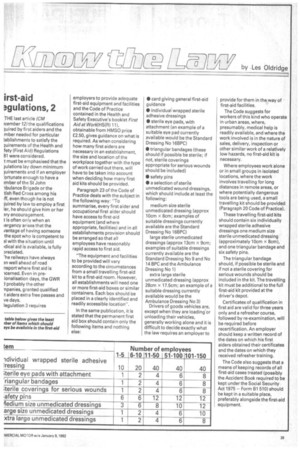irst-aid agulations, 2
Page 33

If you've noticed an error in this article please click here to report it so we can fix it.
THE last article (CM ?camber 12) the qualifications luired by first aiders and the mber needed for particular tablishments to satisfy the luirements of the Health and fety (First Aid) Regulations 81 were considered.
t must be emphasised that the )ulations lay down minimum luirements and if an employer 'ortunate enough to have a )mber of the St John ibulance Brigade or the tish Red Cross among his ft, even though he is not wired by law to employ a first ler, he should give him or her ery encouragement.
t is often only when an iergency arises that the vantage of having someone the spot who is competent to 31 with the situation until tdical aid is available, is fully oreciated.
-he railways have always an well ahead of road nsport where first aid is -icerned. Even in preionalisation days, the GWR probably the other
npanies, granted qualified t eiders extra free passes and ve days.
legulation 3 requires employers to provide adequate first-aid equipment and facilities and the Code of Practice contained in the Health and Safety Executive's booklet First Aid at Woridl-IS(R) 11), obtainable from HMSO price £2.50, gives guidance on what is required. As when considering how many first aiders are necessary in an establishment, the size and location of the workplace together with the type of work carried out there, will have to be taken into account when deciding how many first " aid kits should be provided.
Paragraph 23 of the Code of Practice deals with the subject in the following way: "To summarise, every first aider and occupational first eider should have access to first-aid equipment (and where appropriate, facilities) and in all establishments provision should be arranged so that all employees have reasonably rapid access to first aid.
"The equipment and facilities to be provided will vary according to the circumstances from a small travelling first-aid kit to a first-aid room. However, all establishments will need one or more first-aid boxes or similar containers, Each box should be placed in a clearly identified and readily accessible location".
In the same publication, it is stated that the permanent first aid box should contain only the following items and nothing else: • card giving general first-aid guidance • individual wrapped sterile adhesive dressings • sterile eye pads, with attachment (an example of a suitable eye pad currently available would be the Standard Dressing No 16BPC) • triangular bandages (these should if possible be sterile; if not, sterile coverings appropriate for serious wounds should be included) • safety pins • a selection of sterile unmedicated wound dressings, which should include at least the following: medium size sterile unmedicated dressing (approx 10cm x 8cm; examples of suitable dressings currently available are the Standard Dressing No 16BPC) large sterile unmedicated dressings (approx 13cm x 9cm; examples of suitable dressings currently available are the Standard Dressing No 9 and No 14 BPC and the Ambulance Dressing No 1) extra large sterile unmedicated dressing (approx 28cm x 17.5cm; an example of a suitable dressing currently available would be the Ambulance Dressing No 3) Drivers of goods vehicles are, except when they are loading"or unloading their vehicles, generally working alone and it is difficult to decide exactly what the law requires an employer to provide for them in the way of first-aid facilities.
The Code suggests for workers of this kind who operate in urban areas, where, presumably, medical help is readily available, and where the work involved is in the nature of sales, delivery, inspection or other similar work of a relatively low hazards, no first-aid kit is necessary.
Where employees work alone or in small groups in isolated locations, where the work involves travelling for long distances in remote areas, or where potentially dangerous tools are being used, a small travelling kit should be provided (Paragraph 20 Code of Practice).
These travelling first-aid kits should contain six individually wrapped sterile adhesive dressings one medium size sterile unmedicated dressing (approximately 10cm x 8cm), and one triangular bandage and six safety pins.
The triangular bandage should, if possible be sterile and if not a sterile covering for serious wounds should be included in the kit. The travelling kit must be additional to the full first-aid kit provided at the driver's depot.
Certificates of qualification in first aid are valid for three years only and a refresher course, followed by re-examination, will be required before recertification. An employer should keep a written record of the dates on which his first aiders obtained their certificates and the dates on which they received refresher training.
The Code also suggests that a means of keeping records of all first-aid cases treated (possibly the Accident Book required to be kept under the Social Security Act 1975 — Form B1 510) should be kept in a suitable place, preferably alongside the first-aid equipment.










































